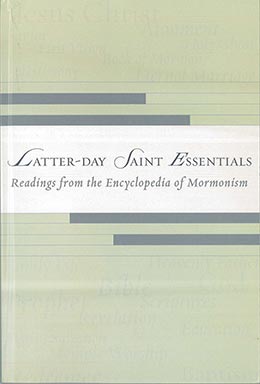First Principles and Ordinances of the Gospel
Marie K. Hafen
Marie Kartchner Hafen, “First Principles and Ordinances of the Gospel,” in Latter-day Saint Essentials: Readings from the Encyclopedia of Mormonism, ed. John W. Welch and Devan Jensen (Provo, UT: BYU Studies and the Religious Studies Center, Brigham Young University, 2002), 96–7.
The first principles and ordinances of the gospel are “first, Faith in the Lord Jesus Christ; second, Repentance; third, Baptism by immersion for the remission of sins; fourth, Laying on of hands for the gift of the Holy Ghost” (Article of Faith 4). The resurrected Savior taught that these principles constitute his “gospel”: “Repent, all ye ends of the earth, and come unto me and be baptized in my name, that ye may be sanctified by the reception of the Holy Ghost, that ye may stand spotless before me at the last day. Verily, verily, I say unto you, this is my gospel” (3 Ne. 27:20–21; cf. Acts 2:37–38). These four principles prepare one to enter the “strait and narrow path which leads to eternal life” (2 Ne. 31:17–18).
First, faith in Jesus Christ often begins with a desire to believe (Alma 32:26–28), which may be kindled by hearing or reading others’ true testimonies of Christ and his Atonement. One nourishes faith by patient obedience to God’s commandments. Faith then grows through a process that includes repentance, baptism for remission of sins, increased confidence in Christ, and eventually a Christlike nature (Hafen, pp. 141–200).
Repentance involves (1) realization of guilt; (2) godly sorrow and suffering; (3) confession for relief from the hurtful effects of sin; (4) restitution, as far as it is possible; (5) replacement of sin with obedience to God’s requirements; and (6) acceptance of Christ’s atoning sacrifice. Through the Atonement, if one repents, Christ’s mercy satisfies the demands of justice.
Baptism, the third principle and first essential ordinance, is the fruit of repentance and is required of all who would be saved in the kingdom of God (John 3:3–5; cf. 2 Ne. 9:23). Baptism has several purposes. It is a symbolic washing and cleansing of sins and is prerequisite to membership in the Church. When followed by the reception of the Holy Ghost, it is the doorway to personal sanctification (Moro. 6:1–4). The prescribed method of baptism is by immersion in water by a priest in the Aaronic Priesthood or by one who holds the Melchizedek Priesthood. “The symbolism of the rite is preserved in no other form” (Talmage, Articles of Faith, p. 137).
Being “born of the Spirit,” or receiving the gift of the Holy Ghost, entitles one to the continual help, guidance, and comfort of the Holy Ghost. “The special office of the Holy Ghost is to enlighten and ennoble the mind, to purify and sanctify the soul, to incite to good works, and to reveal the things of God” (Talmage, Articles of Faith, p. 167). When asked how the Church differed from the other religions of the day, Joseph Smith replied that “we differed in mode of baptism, and the gift of the Holy Ghost . . . [and] that all other considerations [of differences from other churches] were contained in the gift of the Holy Ghost” (History of the Church, 4:42). The gift of the Holy Ghost is conferred by the laying on of hands by a holder of the Melchizedek Priesthood.
Summarizing the process from faith and repentance to sanctification, the Book of Mormon prophet Mormon stated, “And the first fruits of repentance is baptism; and baptism cometh by faith unto the fulfilling the commandments; and the fulfilling the commandments bringeth remission of sins; and the remission of sins bringeth meekness, and lowliness of heart; and because of meekness and lowliness of heart cometh the visitation of the Holy Ghost, which Comforter filleth with hope and perfect love, which love endureth by diligence unto prayer, until the end shall come, when all the saints shall dwell with God” (Moro. 8:25–26).
These four principles and ordinances of the gospel are “first” because they both initiate and enable the process of development from a spiritual rebirth to a divine nature.
Bibliography
Hafen, Bruce C. The Broken Heart: Applying the Atonement to Life’s Experiences. Salt Lake City, 1989.
Kimball, Spencer W. The Miracle of Forgiveness. Salt Lake City, 1969.
Smith, Joseph. History of the Church of Jesus Christ of Latter-day Saints, ed. B. H. Roberts, 2d ed., rev. Salt Lake City, 1957.
